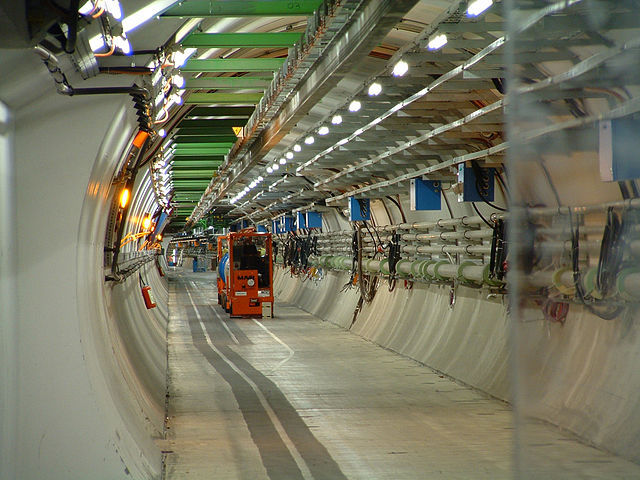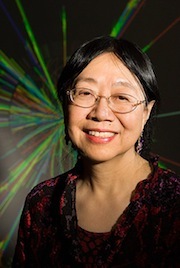As giant physics machine restarts, essential role for UW continues

Research has resumed at the LHC after a two-year project to raise its power. Protons are again moving through a vacuum at nearly light speed in the 27-mile, circular tube on the Swiss-French border.
Photo: Max Braun
The University of Wisconsin–Madison takes pride in the process of “sifting and winnowing, by which alone the truth can be found.” So it makes poetic sense, says Wesley Smith, that he, as a UW–Madison physicist, is overseeing the ultrafast sifting and winnowing procedure for the CMS (compact muon solenoid) experiment, one of two general purpose detectors at history’s largest scientific project, the Large Hadron Collider.
Research has resumed at the LHC after a two-year project to raise its power. Protons are again moving through a vacuum at nearly light speed in the 27-mile, circular tube on the Swiss-French border. Now that the machine has reached its new collision energy of 13 trillion electron volts, the twin beams of protons — each thinner than a pencil lead — contain enough energy to accelerate a 4,000 lb. car from a dead stop to 1,425 mph.
Protons are hydrogen atoms stripped of their single electron.
Wesley Smith with a special-purpose data winnowing board built for the new, high-power runs at the Large Hadron Collider.
Data from the power-hungry machine is needed because the “standard model” of physics, a phenomenally successful description of light, radiation, motion and time, is less effective when it comes to gravity, and breaks down entirely at ultra-high energies like those that immediately followed the Big Bang — conditions that only the LHC can simulate.
In 2012, the giant instrument met its first goal — finding the elusive Higgs particle, thought to explain the existence of mass. In 2013, Peter Higgs and Francois Englert received the Nobel Prize for theorizing this particle back in 1964.
Failing to find the Higgs would have blown a hole in the standard model, but Smith says the discovery raised its own troubles. Although the particle’s characteristics matched predictions, that discovery reinforced the idea that the standard model will be contradictory, even irrelevant, at higher energies.
Although CERN (the European Organization for Nuclear Research, which oversees the LHC) cannot guarantee that practical technologies will emerge from its work, the World Wide Web was invented there in 1989 so scientists could conveniently share files.
Each second at the giant collider, about 1 billion proton collisions produce such a torrent of data that more than 99 percent of it must be forgotten. “You can’t store that much data — you can’t even move it,” says Smith, the Bjorn Wiik Professor of Physics at UW–Madison, “so we hold it in local memory while a subset is sent to the trigger system we have built that decides what tiny fraction to keep.”

Sau Lan Wu
The particle collisions at LHC may be the most powerful in Earth’s history, and as they explore those higher energies, the global clan of LHC physicists hopes to evaluate a promising enhancement on the Standard Model at super-strong energies called “super-symmetry.” Other big game is afoot: LHC research could help explain why a universe that began with equal amounts of matter and anti-matter now contains almost no anti-matter, or why the dominant type of matter in the universe — “dark matter” — can only be detected through its gravitational effects.
UW-Madison has dozens of scientists, including numerous graduate students and postdoctoral fellows, involved in the experiments, analysis, data handling and computation at the LHC. A large group led by Sau Lan Wu, Enrico Fermi and Vilas Professor of Physics, works on the other general purpose detector, ATLAS, concentrating on particle discovery, studying simulated particle collisions and scrutinizing data for evidence of the Higgs boson. The UW–Madison-led Open Science Grid provides experimenters with substantial computing resources under the leadership of computer sciences Professor Miron Livny.
Smith has been working on the electronics and computer systems that preserve the best and forget the rest since 1993, with funding from the Department of Energy and National Science Foundation. The responsibility for directing up to 200 people who designed high-speed electronics and associated software “weighed terribly on me,” he says. “If I messed up and threw away data for the Higgs, we would not have found it. It’s like an unpleasant video game. Other experimenters find the Higgs, but you find nothing, and get fired.”
The Higgs discovery is just a starting point, Smith says. “We have a lot of explaining to do. It’s like embarking on a new adventure. When you land on a new island, you don’t just sail right back home. You explore. And once you start to explore, you may find it strange enough that you don’t want to stay on the beach. You want to go into the interior and find out what is really going on.”




